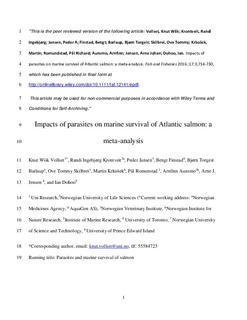| dc.description.abstract | Parasites can, in theory, have large impacts on the survival of fish populations. One method to evaluate such impacts on anadromous species is to apply manipulative field experiments in which parallel groups of antiparasitically treated and non-treated fish are simultaneously released and then subsequently recaptured as returning adults. A systematic review and meta-analysis on all such Norwegian studies on Salmo salar provided a data set for the time period 1996 to 2011 on 118 release groups comprising 657 624 fish released and 3989 recaptured. The overall risk ratio (RR) was estimated to be 1.18 (95% CI: 1.07–1.30). The effect varied strongly between groups, (Higgins I2 = 40.1%). Over 70% of this heterogeneity could be explained by the release location, time period and baseline survival. The most important predictor variable was baseline survival. In groups with low recapture in the control group (low baseline survival), the effect of treatment was high (RR = 1.7), while in groups with high recapture in the control group (high baseline survival), there was no effect of treatment (RR ~ 1.00). The most prevalent parasite in the region affected by the drugs administered was Lepeophtheirus salmonis. Hence, the meta-analysis supports the hypothesis that L. salmonis contributes to the mortality of S. salar during outward migration. However, the effect of treatment was not consistent, but was evidently strongly modulated by other risk factors. The results suggest that the population-level effects of parasites cannot be estimated independently of other factors affecting the marine survival of S. salar. Emamectin benzoate, fish farming, Lepeophtheirus salmonis, parasite, salmon louse, substance EX | |
